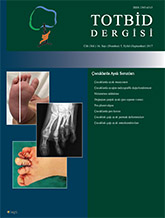
Children are frequently brought to the orthopedic examination by their parents due to complaints about their foot. According to the child`s age group, the complaints of the family and also the problems encountered show differences. Congenital problems are usually the reason for referrals in newborn and pre-gait children. After the walking period, painful conditions are frequently encountered. In addition, some deformities in the physiological limits of toddler may be a cause of concern in their families. A careful story can often give a lot of information about possible diagnosis. The reason for referral to the hospital should be carefully evaluated. Knowing the characteristics of the musculoskeletal system, which is `normal` especially in the newborn period, facilitates accurate evaluation of the foot and avoids unnecessary examinations and treatments. The child`s foot examination is generally performed in the order of observation, palpation and manipulation. Especially in cases of traumatic events, it is very helpful to determine carefully the location of the pain. In outpatient clinics, foot deformities are relatively common among newborns. About threequarters of these deformities are metatarsus adductus. Talipes equinovarus, calcaneovalgus and vertical talus are less commonly seen deformities. Especially after the walking age, complaints of intoeing and traumatic problems are frequent reasons for visiting the outpatient clinics.